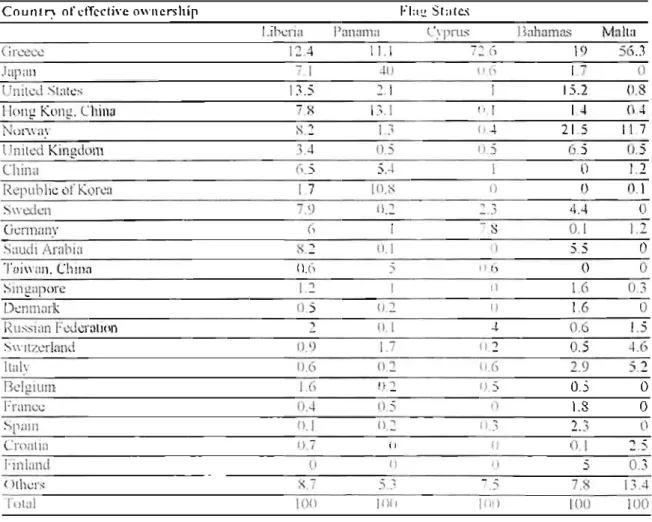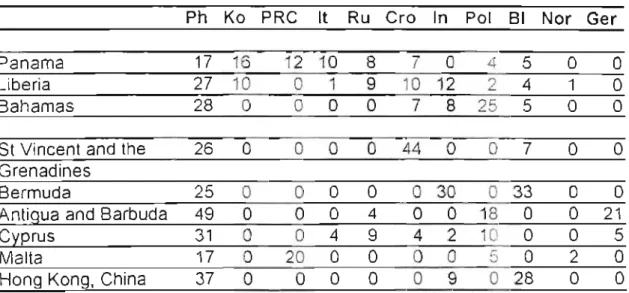I will examine how the shipping industry has restructured since the international economic crisis of the 1970s and the impact of this restructuring process on seafarers. As such, I argue that seafarers and shipping capital are agents of processes of globalization. Therefore, any assessment of globalization and the operation of transnational capital and labor will benefit from an analysis of the way in which the relations between shipping capital and maritime labor are articulated.
Introduction 3
The rise of multinational crew, combined with the increase in FOe registers, has created new shipping centers and labor markets in different regions of the world. By labor proacLove to define new geographic contours of the labor market for ratings outside the TMN. When given a choice to hire officers from regions of Southern and Eastern Europe, shipping companies show a clear preference for officers from the TMN.
Introduction 7
Introduction 8
Conclusion
The aim of this dissertation is to assess the validity of the above claims that capital through its mobility is omnipotent and that labor is 'agentless' in influencing globalization processes. The task I undertake is to assess the validity of the above claims in the prevailing literature. The purpose of the STRC project was to assess the HRD of South African seafarers.
Research Design
For example, according to the ITF (www.itforg.uk), in 1950, 5% of the global shipping fleet registered offshore. It is clearly in the interests of ship management to maintain the status quo on the labor market. This change in the composition of the labor market location was in full swing in the 1980s.
Furthermore, the ITS operate in various sub-committees under the ICFTU and the International Labor Organization (ILO). In the TVCSA, the ITF played a role in the coordinating body for the primarily white and colored bus. This resulted in the ITF committing to work with and promote the recognition of the independent black trade unions.
The role of the ITF inspector is to service SOllth African ratings:llHXlrd FOe vessels. The next section deals specifically with the way in which SATAWU makes use of the considerable resources of the ITF to service South African ratings. International labor solidarity is essential to the successful operation of the FOe campaign because of the campaign's global scope.
In the case of the skippllll; lI1industry this capital is literally mobile 111 the shape of ships. This is part of the ITF's social and welfare program provided to seafarers. FOe shipping has had a direct impact on the economies of these nations due to the shift in employment of ratings from the TMN to the regions of Southern and Eastern Europe.

Labour and the production of space
The ILO recommendation:Hlon was merely a rubber-stamp approval of the ITF proposal (ILO Report: 2001. Northmp and Rowan: 1983). Their suspension has undermined the ITF's ability to represent seafarers from the dc\eJoping world (ibid.). No clear accusations of imperialism or of solilbllY can be made against the ITF.
So the ITF effectively determines the pay scale of SOUlh Afncan seafarers employed on 95% of these ships. According to employers in the shipping industry, the ITF rate boosts South African seafarers in the global market, hence the preference of siPPllIg companies to hire seafarers from elsewhere. Richard Snook, crew manager of Unicorn shippmg: lI1d, chief wage negotiator for the company claims that the wage structure set by I rr is having a negative effect on South African seafarers and that if the ITF agrees to a special rate \\ :Jge for seafarers from South Africa.
This, according to 10 Snook, is well below the ITF minimum wage and is considered by Unicorn to be a living \\:q;c. Employers in the SUtl1!l African shipping industry as a whole joined the ITF in London in 2000. The ITF wage rate also makes it easier for employers to see South African ratings.
Dlamini from SATA WU and Zungu from the ITF were approached by Unicorn to take urgent action with the ITF in London.
Solidarity, space, and class: A contradiction in practice?
Yet much of what passes for imperialism rests on the reality of the exploitation of the people in one region by those in another region. The hope is to prevent the flight of capital across borders and the subsequent loss of work and job security. For example, the accelerating pace of globalization and its effect of accelerating the spatial reconfiguration of the world is the contemporary context.
This chapter has shown that organized labor is a proactive factor in shaping globalization processes. In doing so, it has helped to address the central concern of this dissertation, which is to evaluate claims that portray labor as passive in shaping the processes of globalization. International workers' solidarity has been the strategy of the international workers' movement since the founding of the first international in the nineteenth century.
The way the agency works articulates this may be a result of the dominant political and economic policies of the era, such as the Cold War or globalization. The historical example of how international labor expressed its solidarity with South African unions during the Cold War demonstrates that solidarity as a strategy is effective, but it is also highly contradictory and problematic. As the world shifted from the geopolitics of the Cold War to the geoeconomics of transnational neoliberalism, organized labor had to change its strategy of solidarity.
Politically, the ITF provides one of the best examples of labor articulating its power through the strategy of global solidarity, while ITF policies regarding the wage levels of developing world seafarers IS highly problematic.
Introduction
- SETA,
As far back as 1996, the government was aware of the training problems encountered in the maritime industry. Dlamini (Interview: 2001) praises that South African shipping companies deliberately manipulated the racial division of the labor market. The EEA is a result of the Labor Market Commission report and intense lobbying by South African trade unions 10 addressing racial and gender inequalities in the labor market.
Before the establishment of the TETA, maritime training was managed by the Maritime Industry Training Board (MITS). He holds a key position as Chairman of the South African Maritime Safety Authority (SAJ\I1SA) Transformation Committee. They are all the result of negotiations and consultations between TET A and the union with global shipping companies.
As part of negotiations with global shipping companies, the call for them, from the union and TETA, is to make training places available to South African cadets. It is considered the most viable of the three due to the shipping companies' link to and acquisition of Safinarine. In Dlamini's view, this is an example of the Union being proactive in servicing its membership.
This highlights the adversarial and difficult nature of the relationship between SATA \VU and the shipping companies.
Conclusion
7AP Mollerlivlaersk (one of the world's largest shipping companies) has agreed to provide berths to all cadets once they have completed the academic component of their seafaring training. In this case, it is alarmingly interesting how the union has evaded South African employers in achieving its goals. As this case shows, however, there is a lack of trust and communication between the union and employers.
So there is no leap from separate local/global scales, but rather a recognition of the complex: the interplay between the unique features of the local place (South Africa) and the unique features of the global labor market for sailors and officers . In its role on the SAMSA board, the union has focused on another aspect of the local: the transformation and equality of local maritime institutions such as SAlv1SA itself. Therefore, as chairman of SAMSA's transformation committee, Dlamini played a key role in establishing a black maritime surveyor equity program for SAMSA. It further indicates that the union is aware of the plurality of the local, as opposed to a homogeneous idea of the local.
More importantly, however, the above examples also demonstrate that despite criticism of social partnerships that dilute the power of labor to serve its membership by enforcing consensus, SAT AWU nonetheless articulates its agency at a local level. This complements and intersects with the union's global strategy of international labor solidarity in serving the needs of South African ratings and officers. The findings of this thesis suggest that the labor agency to counter capital cities' mobility and serve a transnational, flexible service. At the same time, however, while agency of labor exists, my study points out that this agency is informed and fractured by different material spatial interests.
I argue that only when a labor organization recognizes that spatial interests intersect and complicate those of class interests can labor agency be transformative rather than merely accommodative (see Chapter Four).
Conclusion 14 7
Further, as chapter four demonstrates, the shift from the geo-politics of the Cold War to the GEC economy of transnational neoliberal globalization has not negated the agency of unions. See Herod's (1997) case study of the geography of contract negotiations in the US East Coast industry for an example of this. A (\998c) The geostatics of labor in post-Cold War Eastern Europe: a study of the activities of the International Union of Metalworkers.
Herodus, A (\998d) Of Blocs, Flows and Networks: The end of the cold war, cyberspace, and the geo economic of organized work at the Fin de Millelaire in. Vrije Universiteit van Berlyn, Duitsland. Mdladlana, M (200 I) Verklaring deur The Minister of Labour by the Lallnch of the Employm Equity Regis/er and the annllo/ repon of (he Commission for Employment Equ iry, http://www.labour.gov.zaJdocslsp/200) )/auW23-mdladlana.htm.
Thompson, P and Warhust, C (1998) Hands, hearts and minds: changing work and workers at the end of the century, in P Thompson and C Warhust (eds) 1I'0rkplaces of,hellllllre. Herod, A (1995) The practice of international work solidarity and the geography of the global economy in Economic Geography 71, no. Massey, D (1994) The geography of trade unions: some issues in Transactions of the Instillfte of British geographers, 19 pp.
Restoring power relations between unions and corporate governance in a globalizing pharmaceutical industry: the case of the acquisition of.
